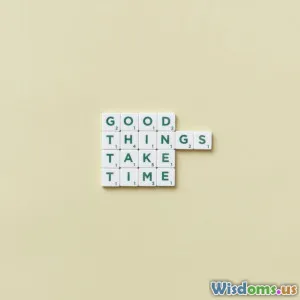Unlock Motivation With Simple Progress Tracking Methods
9 min read Discover how simple progress tracking can unlock motivation and drive consistent success in your goals and projects. (0 Reviews)Unlock Motivation With Simple Progress Tracking Methods
Motivation can seem elusive. You start a new goal full of enthusiasm only to lose steam days or weeks later. Yet, successful people share a common strategy: simple, consistent progress tracking. This overlooked technique transforms vague ambitions into tangible actions. It fuels motivation, holding you accountable and clearly showing your achievements.
In this article, we'll delve deep into how you can unlock motivation by implementing straightforward progress tracking methods. You'll learn why tracking progress is a game-changer, explore various easy-to-adopt strategies, and see how these help build momentum for sustained success.
Why Tracking Progress Unlocks Motivation
Progress tracking works because it provides continuous feedback and a visible roadmap. Psychological research underscores the importance of immediate, measurable progress in maintaining motivation. Dr. Teresa Amabile, a professor at Harvard Business School, found that even minor wins dramatically boost workplace motivation and engagement.
The Science Behind Motivation and Feedback
Humans are wired to seek progress—it's a fundamental driver in behavioral psychology. The Zeigarnik Effect explains that incomplete tasks linger in our minds, increasing our desire to complete them. Tracking progress externalizes that concept, turning mental clutter into clear, manageable increments.
Moreover, visible progress taps into the brain's reward system by releasing dopamine, the neurotransmitter linked to pleasure and motivation. When you mark a task as done or move a step forward, your brain rewards you, motivating continued effort.
Accountability and Momentum
Progress tracking creates accountability—even if it is personal. When you document achievements daily or weekly, you cultivate a habit—making procrastination less likely. Momentum builds naturally; each recorded success propels you toward the next, creating an amplification effect known as the “progress spiral.”
Simple Methods to Track Progress and Boost Motivation
You don’t need extravagant tools or apps to start. Simple methods can be highly effective and easier to maintain.
1. The Classic Checklist
One of the oldest yet most effective techniques is a physical or digital checklist. Crossing off completed tasks offers satisfying visual proof of progress.
Example:
- If you're learning a new language, list daily practice activities: 15 minutes of vocabulary, 10 minutes listening, or 5 new sentences to write. Checking them off daily keeps motivation high and tracks consistency.
Benefits:
- Clear task completion
- Visual progress that boosts dopamine
- Easy to customize
2. Progress Bars and Charts
Creating a progress bar or chart for your goal quantifies how far you’ve come and how far you need to go.
Example:
Weight loss programs often use progress bars to show the percentage of the goal completed. Visiting this visual every day reminds users of their achievements and encourages sustained effort.
Tools to Help: Excel, Google Sheets, or apps like Habitica transform measurement into a visual gamified experience.
3. Journaling with Milestones
Journaling provides space to reflect on achievements, challenges, and next steps.
Example:
If your goal is to write a book, maintain a journal logging daily word count and emotional responses. Set weekly or monthly milestones for chapters completed. Reflecting on your entries reminds you of growth beyond just numbers.
Benefits:
- Emotional engagement and reflection
- Recognizing non-quantitative progress
- Tracking mood and motivation patterns
4. Habit Tracking Apps
The digital age offers many apps focused on habit and progress tracking.
Examples:
- Streaks: Encourages maintaining consecutive day streaks on goals.
- Coach.me: Combines tracking with a coaching community.
- Forest: Uses gamification to stay focused and track progress.
These tools simplify logging progress, send reminders, and provide data trends so you can assess effectiveness.
5. Visual Boards and Sticky Notes
Physical visual reminders in your workspace or home reinforce motivation.
Example:
A Kanban board with columns: To Do, In Progress, and Done, visually moves tasks towards completion. Sticky notes representing each task can be moved, giving a powerful tactile sense of achievement.
Benefits:
- Tangible feeling of progress
- Helpful for team or solo work
- Customizable and low cost
Real-World Insights and Success Stories
A Study in Corporate Settings
Gallup’s research indicates employees with access to clear progress structures are more engaged. Firms using progress-tracking tools report up to a 21% increase in productivity.
Author Austin Kleon and Habit Tracking
Austin Kleon, author of "Keep Going," advocates “one line a day” journaling to track writing progress. This simple habit captures visible success and momentum underpinning motivation throughout his creative endeavors.
Self-Experiment: The Power of Daily Checklists
In a self-experiment documented by productivity expert James Clear, implementing daily checklists increased completion rates for all goals by 40%. Keeping it simple was key to adherence and impact.
Best Practices to Maximize Your Progress Tracking
Consistency Over Intensity
Daily tracking—even brief check-ins—outperforms sporadic deep dives. Building the habit of regular reflection maintains motivation engines steadily revving.
Personalize Your Method
Choose tools and methods that fit your lifestyle and preferences. If you dislike digital complexity, opt for paper methods. Enjoy visual stimuli? Consider color-coded charts.
Keep Goals Realistic and Break Them Down
Large goals can be demotivating if progress seems imperceptible. Breaking goals into bite-sized chunks ensures frequent wins.
Celebrate Wins
Take time to celebrate milestones. Even micro wins deserve recognition, cementing positive associations with progress.
Record Challenges and Learn
Tracking setbacks isn’t failure; it’s data. Understanding obstacles lets you pivot intelligently and maintain motivation.
Conclusion
Motivation is not a mysterious force; it is a process nurtured by visible, consistent progress. Simple progress tracking methods transform overwhelming aspirations into manageable, exciting journeys. Whether through checklists, apps, journals, or visual boards, committing to tracking your progress unlocks a feedback loop that fuels motivation and ultimate success.
Start small today—pick one simple method from this article and integrate it into your routine. Notice how your mindset shifts from hesitation to action, distractions to focus, and dreams to accomplished goals. Motivation awaits at the end of each checkmark.
References
- Amabile, Teresa M., and Steven J. Kramer. The Progress Principle: Using Small Wins to Ignite Joy, Engagement, and Creativity at Work. Harvard Business Review Press, 2011.
- Gallup, State of the Global Workplace Report, 2022
- Kleon, Austin. Keep Going: 10 Ways to Stay Creative in Good Times and Bad. Workman Publishing, 2019.
- Clear, James. Atomic Habits. Avery, 2018.
Unlock motivation by embracing progress tracking—the simplest key to achieving remarkable success.
Rate the Post
User Reviews
Popular Posts



















